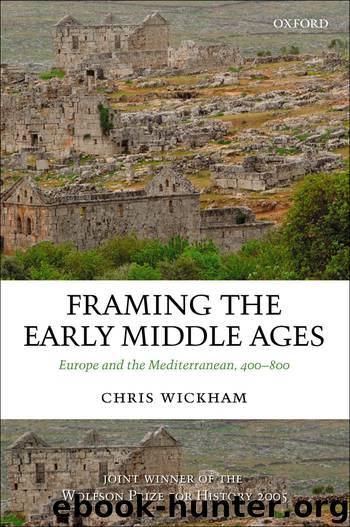Framing the Early Middle Ages by Wickham Chris;

Author:Wickham, Chris;
Language: eng
Format: epub
Publisher: Oxford University Press
Published: 2005-04-09T04:00:00+00:00
3. Where did post-Roman aristocrats live?
In the Roman empire, almost every major political figure was urban-based. This bald statement needs immediate qualification, for military leaders did not necessarily have the same identification with a city as did senatorial and curial aristocrats, and indeed frequently came from frontier regions, above all the northern Balkans, where cities were relatively weak; but the higher they rose the more they gravitated to the urban centres of political power, as with Aetius and Aspar, contemporaries of Balkan and Alan origin respectively, whose points of reference were Ravenna and Constantinople, or Belisarios, who was also from the Balkans, but who retired to Constantinople.17 It must also be stressed that city-based western aristocrats had rural houses as well, the sumptuous villas praised by writers like Sidonius, where they spent the summer months, and occasionally overwintered too (above, pp. 467–8); where exactly the ‘primary’ base was for a rich landowner with many such estates, particularly one who was keener on otium than on urban or imperial office, may have been no clearer then than it is now. But the exclusive association between city living and the exercise of direct political authority, with all the public money that was attached to it, made it hard for any major figure to turn his back on urban society altogether. Only the antisocial and perhaps the elderly did it, like Asturius, an irascible senator who had retired to the Alpine foothills, probably from Milan, in the early sixth century.18 It may be that, at the very end of the western empire, city-dwelling was less entirely normal for aristocrats. Apart from Sidonius’ letters on the subject, already mentioned, historians tend to cite Cassiodorus’ letter of 526/7, requiring the possessores et curiales of Bruttii, modern Calabria in the toe of Italy, to return to the ‘human society’ of the cities, rather than burying themselves in their rural houses. Was this trend restricted to Bruttii, a politically marginal area, or was it more widespread in Italy, and only associated with Bruttii because Cassiodorus was himself from there, and kept more of the letters he wrote about it? We cannot be sure. As long as the Ostrogothic state remained strong in Italy, however, possessores who left cities ran the risk of cutting themselves off from political influence and exposing themselves to the power of others—to adopt Sidonius’ punning words about the situation in Gaul, ‘not so much being praised by the censor (honorare censor) as being burdened by the tax-collector (censetor onerare)’.19 So much bad happened in Italy in the next decades, however, that whether this one letter really represents a trend is a bit beside the point; we cannot easily trace the (anyway weak) tradition of rural aristocratic landowning in post-Roman Italy to Bruttii.
In the East, where even summer aristocratic retreats were rare, outside, probably, parts of eastern Anatolia (above, p. 462), the countryside was more marginal still. Rural-based elites under the empire seem never to have been more than medium owners, as at Serjilla and Nessana (above, pp.
Download
This site does not store any files on its server. We only index and link to content provided by other sites. Please contact the content providers to delete copyright contents if any and email us, we'll remove relevant links or contents immediately.
| Africa | Americas |
| Arctic & Antarctica | Asia |
| Australia & Oceania | Europe |
| Middle East | Russia |
| United States | World |
| Ancient Civilizations | Military |
| Historical Study & Educational Resources |
Room 212 by Kate Stewart(4766)
The Crown by Robert Lacey(4584)
Endurance: Shackleton's Incredible Voyage by Alfred Lansing(4528)
The Iron Duke by The Iron Duke(4135)
The Rape of Nanking by Iris Chang(4032)
Killing England by Bill O'Reilly(3901)
Joan of Arc by Mary Gordon(3808)
Say Nothing by Patrick Radden Keefe(3738)
I'll Give You the Sun by Jandy Nelson(3277)
Shadow of Night by Deborah Harkness(3189)
Hitler's Monsters by Eric Kurlander(3179)
Mary, Queen of Scots, and the Murder of Lord Darnley by Alison Weir(3086)
Blood and Sand by Alex Von Tunzelmann(3068)
Darkest Hour by Anthony McCarten(3022)
Margaret Thatcher: The Autobiography by Thatcher Margaret(2976)
Eleanor & Park by Rainbow Rowell(2951)
Red Famine: Stalin's War on Ukraine by Anne Applebaum(2818)
Book of Life by Deborah Harkness(2735)
The One Memory of Flora Banks by Emily Barr(2695)
